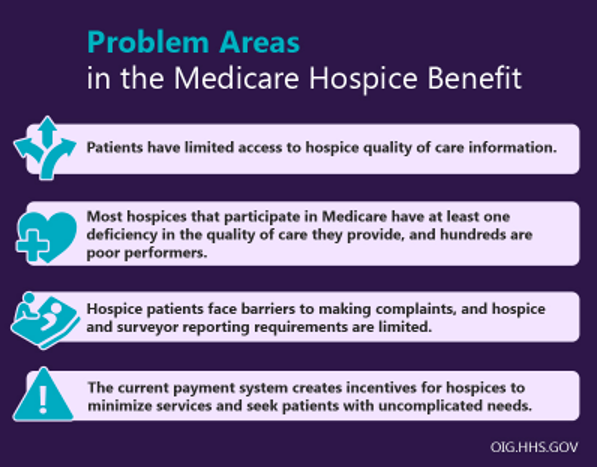Mary Madison, RN, RAC-CT, CDP
Clinical Consultant – Briggs Healthcare

Hospice care is for terminally ill patients who decide to forgo curative treatment and instead receive palliative care. To be eligible, a patient must be certified as having a terminal illness with a life expectancy of six months or less if the illness runs its normal course. Hospice care generally includes nursing and aide services, drugs, and supplies. It may be provided in a variety of settings, such as the patient’s home, a nursing facility, or an assisted living facility. About 1.7 million Medicare beneficiaries receive hospice care each year, and Medicare pays about $23 billion annually for this care.
OIG provided an update on the Hospice program on March 28, 2023.
Years of OIG audits, evaluations, and investigations into hospice care have revealed that, while these services can provide great comfort to terminally ill patients and their families, there are significant problems with the program. Our reports and investigations have revealed several concerning issues, including poor—sometimes harmful—quality of care, fraud schemes that involve enrolling beneficiaries without their consent, inappropriate billing practices, limited transparency for patients and their families, a payment system that creates incentives to minimize services, and a rapid growth in the number of new hospices, often to take advantage of these conditions.

To protect hospice patients, OIG conducts extensive audits and evaluations of the hospice program, monitors the impact of program changes, and investigates concerning allegations of fraud and abuse. The key priorities of OIG’s hospice oversight are below.
- Ensuring Quality of Care and Preventing Patient Harm
OIG has recommended changes to promote quality of care and prevent patient harm. These changes include increasing oversight of hospices with a history of serious deficiencies, strengthening requirements to report abuse and neglect, and creating user-friendly mechanisms for patients and families to submit complaints.
- Building Transparency and Access to Information
We (OIG) have recommended that CMS include information about complaints filed and resulting deficiencies, as well as survey reports from State agencies and accrediting organizations, on Hospice Compare. We (OIG) also have recommended adding information about the average number and types of services a hospice provides, how often physicians visit, and how often a hospice provides services on weekends.
- Promoting Accurate and Effective Billing Practices
OIG has recommended that CMS take steps to tie payment to patient needs and quality of care, seeking statutory authority if necessary. These changes, coupled with strengthened oversight measures, would help ensure that services rendered adequately serve patients.

There’s a lot of information in this report to digest and share, including:
- Resources for Patients and Families
- Featured Reports
- Additional Resources (Enforcement Actions and Work Plan Items)
Please share with your team and PAC colleagues.
